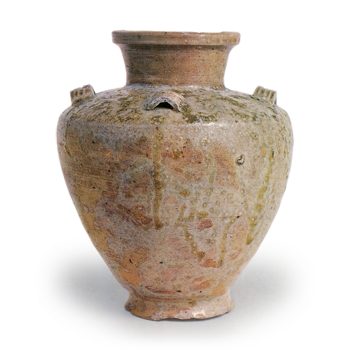
13th century
Height 21.7cm, Bowl diameter 9.9cm, Body diameter 18.5cm, Bottom diameter 8.8cm
This wide-mouthed jar with four ears affixed to the shoulder is one of the representative forms of medieval Seto ware, and was the longest-lasting type of ware from the early to the late periods. As a rule, ash glaze was used for the glaze, but iron glaze was often applied from the mid-Muromachi period onward. Needless to say, the prototype of this type of four-lobed vase originated in China during the Song dynasty (960-1279), and was imported in large numbers at the end of the Heian period (794-1185) and used as bone ware or sutra case outer vessels. It has become clear in recent years that four-lobed vases had already been produced at the Sanage and Mino Sue kilns since the late Heian period, before being produced in large quantities at Seto in the mid Kamakura period.
Although small in size, this four-mimi jar is considered to be an early Koseto piece, probably made in the middle of the Kamakura period (1185-1333), based on the shape of the outer orifice and the strongly stretched shoulders. There are no patterns on the surface yet, and the yuzu glaze is simple and unevenly applied with a brush, showing a runny glaze although it is well melted. The base is made of high-quality grayish-white clay, which has been well fired to produce a brown fire color over almost the entire surface. This is one of the representative examples of early four-mimi jars.



